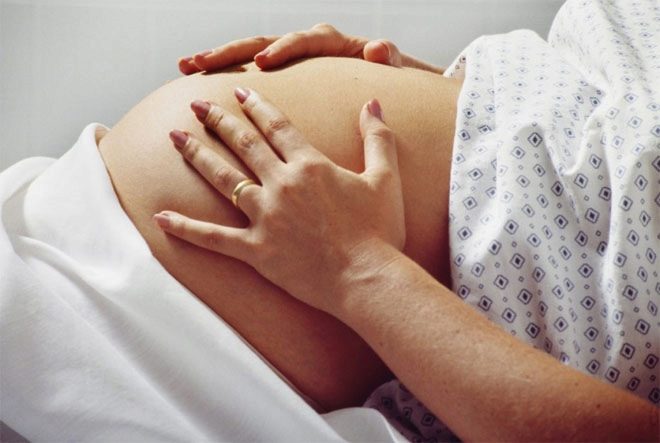How to survive the fight? TOP effective ways
Labor contractions are considered the most painful stages of childbirth. This is partly true. But much depends on how sensitive a woman is and on whether she knows how to behave during contractions. There are simple and effective techniques that allow you to survive the fight with the least damage to the psyche of the woman in labor. In this article we will tell you what to do to make the contractions less painful.
Why does it hurt?
The physiology of uterine contractions in labor is fairly simple. Each subsequent contraction (contraction) helps to keep the uterus tightly closed during pregnancy. The neck widens, the muscle fibers become shorter and smoother. Gradually, uterine walls are drawn into the contraction. When the neck opens completely, the baby’s head can pass through it. The attempts will begin.
The period of labor is the longest stage of labor. In primiparous women, it can last 10–12 hours or more, in women with experience, from 6 to 10 hours. The shortest contractions are only 20 seconds, they usually begin labor activity. The longest last about a minute. As they develop, the real (true) contractions become stronger, their duration increases, and the intervals between episodes of contractions are shortened. Before attempts, they can occur every 2 minutes, while the duration of each spasm will reach 1 minute. Pain also increases with the development of contractions.
The first period is called latent (hidden). At this time, contractions are not so painful, they do not cause severe pain, they repeat every 15-30 minutes, lasting an average of 20-25 seconds. In this stage a woman can stay for a rather long time - up to 7-8 hours. During normal childbirth during this period, the cervix is revealed to 3 centimeters. The second period is called active. The contractions become more painful, their duration - from 30 to 60 seconds, the intervals for rest become shorter - from 4 to 2 minutes. This stage lasts from 3 to 5 hours, during which time the neck opens up to about 7 centimeters.
This is followed by the third phase - transitional contractions begin. The period lasts from half an hour to one and a half hours. The strongest fights, their duration is about a minute, the repetition interval is 1-2 minutes. The cervix is revealed to 10 centimeters, which is quite enough for the transition to the attempts. The cervix is a circular muscle, the expansion of which is always quite painful. Before childbirth, the woman’s body, the pituitary gland and the placenta begin to produce special substances whose task is to increase the contractile capacity of the uterine muscles. If these substances are not enough, childbirth can go with complications against the background of weak labor forces.
Sensations
What a woman feels during contractions is difficult to describe, because the sensations will be bright and varied. When everything is just beginning, pain can be compared with pain during menstruation, only ten times stronger. The aching, breaking, pulling attacks occur with a certain frequency. The uterus tenses, for some time remains in this tension (this is the duration of the contraction), and then relaxes.
A woman cannot manage this process, the occurrence of a contraction and its duration are in no way dependent on the will of the woman.
The pain is shingles. If at the beginning there is a feeling that only the stomach kamenet, then gradually the back, the loin, the sacrum, the lower and the upper abdomen are drawn into the process. Moreover, the pain originates in the back, girdles it, goes down, goes to the stomach, and then rises to the bottom of the uterus. Then relaxation occurs. By the cyclical nature and regularity of labor contractions at birth, at the very beginning, they can be distinguished from precursors. False contractions can be irregular, while the true ones always follow the rhythm of nature, never lagging behind or advancing from it.
The best ways to alleviate the condition
Tips to endure fights, gritting his teeth, or shouting to ease - harmful and dangerous. No shouting, no moaning or gritting your teeth is necessary. There are other truly useful and effective ways to survive the contractions and not go crazy with pain.
Psychological attitude
It has long been observed that the more a woman is afraid of birth pain, the harder and longer the birth in general and the period of labor in particular take place. Self-hypnosis is a great way to ease the contractions and make them unbearably sick almost from the latent period. Preparation should be to ensure that during pregnancy a woman eliminates the impact of negative information. There is no need to read scary stories about difficult childbirth that happened to others.
When true contractions begin, a method of psychological visualization of a target helps a lot.
To do this, you need to imagine as brightly as possible that each fight brings the birth of a child closer. Women usually have a more developed imagination than men, and therefore you can try to imagine something distracting, for example, the gentle surf that covers you lying on the surf line and rolls back (the beginning and end of the spasm, respectively). If there are no prejudices about the partner childbirth, at this stage the spouse or one of the relatives can support, distract with conversation.
Breath
Proper breathing can not only distract from fear, but also naturally relieve uterine spasms. This is due to the fact that the flow of oxygen causes an enhanced production of endorphins - the hormones of happiness, which, in addition to the feeling of joy and lightness, give a pronounced anesthetic effect. One of the best methods is considered Kobas breathing - a technique created by the gynecologist Alexander Kobasa. She says that at the very beginning a woman should breathe calmly and evenly, deeply. In this case, it is not necessary to lie in bed, you can walk and move. Such rhythmic breathing will allow you to achieve a certain relaxation.
In the active stage of contractions, deep breathing alone will not be enough. It is recommended to save oxygen and make longer expirations. At 1-2-3-4 inhale, at 1-2-3-4-5-6 - exhale. Intensive transitional bouts the doctor recommends “breathing” with small and frequent shallow breaths (as dogs breathe, as candles blow out on the cake). If you do everything correctly and do not stray from the rhythm, you can achieve quite a powerful pain medication effect.
Massage
If the childbirth is a partnership, a close person can do the anesthetic massage; if the woman is alone in the hospital, she can do self-massage. Mass the rhomboid space above the gluteal fold, the so-called Michaelis rhombus.
Thumb cushions can rub and knead this area, make point circular or linear movements. Each woman can choose for herself the type of impact that will be the most pleasant. Well helps to survive intense contractions rubbing the massage area with his hands and scrolling cams clockwise and counterclockwise. Use active points on the face - in the early stage of contractions before the active phase of labor, a circular massage of the earlobes, points over the wings of the noses and in the temples area helps perfectly.
Movement and other actions
Contractions in the prone position is not the best solution for a woman who is firmly determined to survive this period most gently. If there are no medical contraindications against being upright, you can and must move, walk throughout the latent phase of contractions (until the cervix is opened within 3 centimeters). At the peak of the bout, a little easier is the state of changing the body position - if you are sitting, you need to get up, if you are standing, take a step forward.
When the disclosure is from 3 to 7 centimeters, active movements are not shown. But a woman is quite possible to take a knee-elbow posture with a deflection in the spine, to sit on the bed on her knees with legs wide apart. Some during childbirth it becomes easier if you stand in front of a table or headboard and from time to time lean on the support. Today, almost all maternity hospitals are equipped with a sufficient number of bathrooms, so with the permission of the doctor you can go to the shower, it greatly alleviates the condition.
During contractions, it is advisable to go to the toilet for a small need every hour, as the crowded bladder is clearly not conducive to relaxation.
Reviews
According to women, modern medicine is ready at any moment to help, if the contractions become very painful, the woman will start to panic and stop coping with the pain. Anesthetic injections can be given, which will dull the sensations and help to survive difficult moments. The main thing, according to moms, is to recognize the moment when the pressure will become strong against the background of pain relief - So the attempts begin, and you need to call the doctor or obstetrician as soon as possible, if they are not constantly with the woman in childbirth.
Other effective ways to relieve the process of contractions can be found in the following video.































